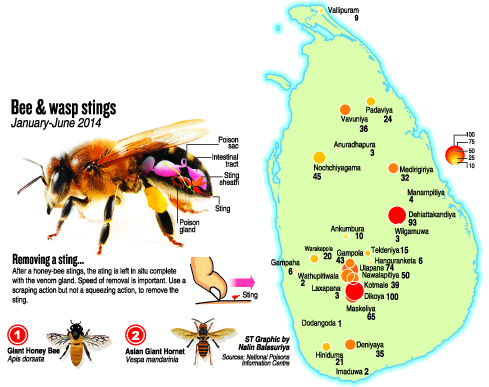News
Flying insect stings top 700 for 2014 first half
Nearly 750 people from across the country have sought hospital treatment within the first six months of this year after being stung by bees and wasps, while there is no record of how many stayed home and resorted to other remedies.
This is why the Poisons Information Centre is strongly urging that ‘flying-insect stings’ be considered a separate category in health data without including them under the wide and varied category of ‘animal bites’.

Dr. Waruna Gunathilake
“Insect stings particularly those of bees and wasps (which also include hornets) are an unidentified and unaddressed issue and send numerous people to hospital,” points out Dr. Waruna Gunathilake, Head of the Toxicology & National Poisons Information Centre based at the National Hospital in Colombo.
While explaining that such incidents are highlighted when attacks occur at Sigiriya, he underscores the fact that a study conducted by the National Poisons Information Centre clearly indicates that they happen all over the country with a higher concentration in estate areas.
The telephone survey to collect the data had been carried out by Dr. B.V. Keerthisena under the guidance of Dr. Gunathilake.
The data show that the problem of flying-insect attacks has not been addressed either zoologically or medically, according to Dr. Gunathilake who argues that even in health statistics they do not fall under a separate entity. There  are ‘dog bites’ and ‘snake bites’ but flying-insect stings are under ‘animal bites’.
are ‘dog bites’ and ‘snake bites’ but flying-insect stings are under ‘animal bites’.
“We need to specify the stings of bees and wasps and as such the data collection format should be revised,” he says.
The issues around these insect stings are multi-pronged, the Sunday Times learns, not only limited to health but also social and economic aspects.
“We need to find out the loss of income to people who have to seek treatment at hospitals after being stung by these insects, how they would be able to take time off work and the impact on their homes, if they are women and have to leave young children behind,” says Dr. Gunathilake.
Are such insect-stinging incidents on the rise in the country and if they are, is global warming having a hand in it, similar to a rise in vector-borne diseases? To determine all this, we need statistics, according to him.
Pointing out that there also seems to be limited research carried out in Sri Lanka on this subject, he says that the observations of the National Poisons Information Centre have found that where earlier flying-insect nests were atop trees, now they are at tea-bush level, hidden among the tea-bushes. “We are being told by people working in tea estates that these insects are seeking protection for their nests at a lower level because swoops on the nests by birds which relish the larvae have increased,” says Dr. Gunathilake, questioning why.
“We can only speculate,” he says. Have the food sources of these birds become scarce or are there more birds than there are food sources?
Environmental sources say the flying-insect nests are usually attacked by the oriental honey buzzard.
Meanwhile, the contention of Dr. Gunathilake is that it is the tip of the iceberg. “We need an in-depth assessment,” he says, seeking collaboration from zoology departments of universities and even individual zoologists to find the answers.
| Prevention and response if stung
Dark colours such as black and blue are an attraction, as also perfume and the odour of beer and sweet sodas, says Dr. Waruna Gunathilake, advising people to try as much as possible to avoid them if they are in areas where these flying insects roam. If stung, the sting should be removed with care. If the sting-spot is squeezed with the fingers, as we often do, to remove the embedded sting, the chances are that the venom apparatus which is atop the sting will pump more poison into the victim. Therefore, it is better to take a piece of paper and attempt to take out the sting sideways, he says. In many cases, an insect-sting causes redness and swelling at the spot but there could also be anaphylactic shock and sometimes rarely renal failure and myocardial infarction (a heart attack), he adds. |

